Note: all of these images have been resampled, and contrast adjusted to bring out the most detail
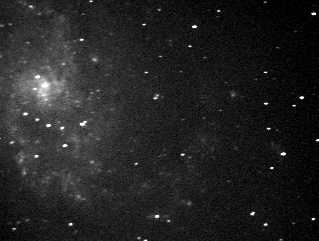
M33, 60 sec: Taken 3.11.2000 at Goodsell Observatory through an LX200 at f/6.3
Some of the most impressive objects to image (in my opinion) are those that are the farthest from
us. I'm talking about Galaxies. They come in all shapes and sizes and colors and range from the
relatively close (M31) to those on the edge of the universe (those in the Hubble deep field). Most
of those that I took pictures of were of the relatively close variety, as I would not be able to
image ones that were too distant (and thus, dimmer).
First, M33, which is a lovely galaxy, and stands out the instant you find it (readily visible in only
a 10 second exposure, though this one is 60 seconds in length).
Note: all of these images have been resampled, and contrast adjusted to bring out the most
detail

M33, 60 sec: Taken 3.11.2000 at Goodsell Observatory through an LX200 at f/6.3
Here is another version of the above picture, except the contrast was scaled logarithmically.
You decide which one is better...

M33, 60 sec: Taken 3.11.2000 at Goodsell Observatory through an LX200 at f/6.3
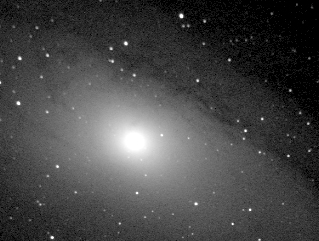
One of my goals for this term (that I set this summer, not knowing what I was getting into), was
to get a set of pictures of all of Andromeda by the end of the term, preferably in color. This was
a larger undertaking that I thought it would be, and I was not able to complete it. However, I did
learn many things about taking color images and long exposures, which will help me in the
future (next time there is a good clear night, I intend to try again). Taking good images of
galaxies takes a long time: 40seconds to 3 minutes or more for one exposure (often taken in
sections to reduce bluring and movement artifacts from inaccuracies in the telescope's drive).
That's a lot more than the .01 seconds for a decent exposure of Jupiter!
One of the first other galaxies I went looking for was one that Voyager said should be near
Mirach, a bright star in Andromeda. I decided, since I would be using Mirach as the starting
point for my search for the asteroid 2000 UG11 on 3 November, I might as well see if I could
find the galaxy near it. Sure enough, there is something non-stellar (i.e. not point-like)
to the upper right of Mirach (that completely washed-out, over-exposed and big thing on the
bottom-middle). This was a 10second exposure, because I was afraid if I took anything more than
that I would completely lose the galaxy to Mirach's over-exposure, but if it was less I wouldn't
be able to find the galaxy. I think I could have safely increased the exposure, though I am not
sure by how much.
This had the contrast scaled logarythmically, to bring out the galaxy. Using a log scale on the
contrast is a way to bring out dim objects, but loses some of the detail.
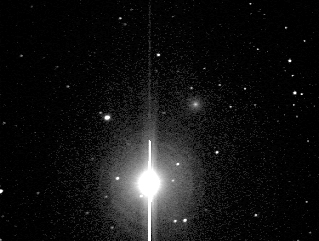
NGC404 10 sec: Taken 3.11.2000 at Goodsell Observatory through an LX200 at f/6.3
Some other galaxies I imaged were taken while attempting to find the asteroid 2000 UG11.
That story is on another page, but I've placed the pictures I took on this one, because
this is where they make more sense. The descriptions of my route to UG11 fit with the
order that I have listed these images.
NGC672 was the first one after NGC404. After I took the picture, I saw there was another galaxy
there as well! It turns out that NGC684 was also in the field of view of this, and I wasn't
even expecting it! Both are spiral galaxies with respective magnitudes of 11.3 and 13.2.
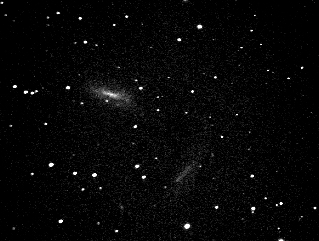
NGC684, 40 sec: Taken 3.11.2000 at Goodsell Observatory through an LX200 at f/6.3
Next were NGC777 and NGC778. These are two spiral galaxies at 12.3 and 14.2 magnitude
respectively. NGC777 is slightly above and right of center, while NGC778 is below and right of
center (and quite dim, though it looks less like a star than NGC777). The contrast here was
once again scaled logarithmically, to make them both more visible in a typical browser.
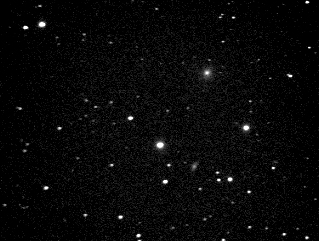
NGC777, 40 sec: Taken 3.11.2000 at Goodsell Observatory through an LX200 at f/6.3
Now came NGC925, which is another spiral at 10.2 magnitude. You can possibly a barred spiral
structure in this set of three combined 40 second images (which I would like to investigate in
more detail in the future).
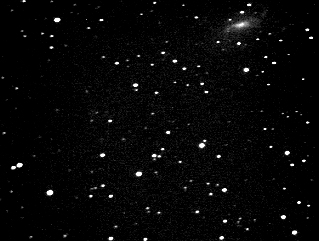
NGC925, 3x 40 sec: Taken 3.11.2000 at Goodsell Observatory through an LX200 at f/6.3
NGC972 was near the end of this journey. It is a spiral galaxy at magnitude 12.3.
This image came from overlaying three 40 second images, which helps bring out detail.
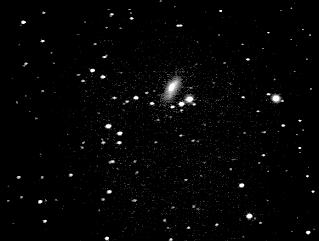
NGC972, 3x 40 sec: Taken 3.11.2000 at Goodsell Observatory through an LX200 at f/6.3
Finally we have NGC1156, at magnitude 12.1. Once I had found this one, I knew I was close
to my final destination of 2000 UG11...
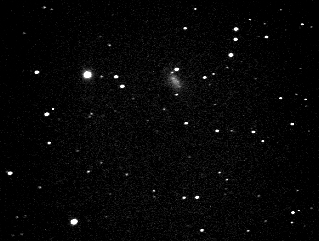
NGC1156, 40 sec: Taken 3.11.2000 at Goodsell Observatory through an LX200 at f/6.3